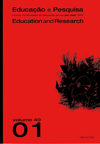Early mathematical concepts and language: a comparative study between deaf and hearing children
DOI:
https://doi.org/10.1590/S1517-97022014000100011Abstract
Research has shown that children who develop typically build mathematical concepts very early. This process of cognitive development seems to be closely connected with the development of verbal language. What happens to the mathematical development of children who have a different form of language such as the sign language used by deaf people? This question, and other questions about deaf students' low performance in mathematics documented by other studies guided the development of the study presented here. To answer these questions, experimental tests were carried out with deaf children (group 1), younger hearing children from public schools (group 2), older hearing children from public schools (group 3) and children from private schools (group 4). The results evidenced a clear distinction between mathematical cognitive skills more dependent and less dependent on linguistic stimuli, notifying that deaf children have the same performance, or in some cases even higher performance than hearing children in skills less dependent on linguistic stimuli. However, both deaf children and younger hearing children from public schools had a significantly lower performance in comparison to older hearing children from public schools and children from private schools. This result indicates that deafness is not a cause of poor academic performance in mathematics. Thus, it seems necessary to think of forms of pedagogical intervention which can ensure the successful learning of mathematics for both deaf children and hearing children who attend public schools in Brazil.Downloads
Download data is not yet available.
Downloads
Published
2014-03-01
Issue
Section
Articles
License
Authors assume exclusive responsibility for the concepts expressed in their articles, which do not necessarily reflect the journal’s opinion.
Permission to photocopy all or part of the material published in the journal is granted provided that the original source of publication be assigned.
How to Cite
Early mathematical concepts and language: a comparative study between deaf and hearing children . (2014). Educação E Pesquisa, 40(1), 163-179. https://doi.org/10.1590/S1517-97022014000100011



